
Ichneutica lissoxyla is a moth of the family Noctuidae. It is endemic to New Zealand. It is found in the central and southern parts of the North Island and in most parts of the South Island. The species prefers snowgrass habitat in the alpine zone. I. lissoxyla is similar in appearance to I. paraxysta but can be distinguished as I. lissoxyla lack the black streaks on the forewings that can be found on the latter species and the male I. lissoxyla also has longer pectinations on antennae. The life history of this species is unknown as are the host species of its larvae. Adults are on the wing from January to April and are attracted to the light.

Ichneutica nullifera is a moth of the family Noctuidae. This species is endemic to New Zealand and can be found in the Tongariro National Park, along the Wellington coast and throughout the South Island. The adults are large and the forewing of adults can vary in colour from pale fawn to dark grey. The larvae are coloured a bright yellow-brown with a paler underside. The larval host species are in the genus Aciphylla and as a result the adult moths are often found in habitat dominated by species in this genus. Adults are on the wing from November to early April and are sometimes attracted to light.

Ichneutica pelanodes is a moth of the family Noctuidae. It is endemic to New Zealand and has been found in scattered locations in the North, South and Stewart Islands. I. pelanodes is easily confused with I. skelloni as the two species are visually extremely similar. In the North Island though the range of the two species appears not to overlap. Generally of the two species I. pelanodes tends to be darker in appearance. I. pelanodes inhabits wetlands but the life history of this species is unknown as are the host species of its larvae. Adults are on the wing from October to February and are attracted both to sugar and light traps.

Ichneutica scutata is a moth of the family Noctuidae. It is endemic to New Zealand. This species can be found in the southern parts of the North Island as well as the eastern parts of the South Island. It is similar in appearance to I. insignis and I. skelloni but can be distinguished as I. scutata is much paler in appearance. It is likely this species inhabits lowland tussock grasslands as well as coastal dunes although it is not common in inland tussock grasslands. The larvae feed on a variety of herbaceous plants such as Plantago and Convolvulus species, Plagianthus divaricatus. It pupates on soil near its host plants. The adults are on the wing from late March to July.

Ichneutica acontistis is a moth of the family Noctuidae. It is endemic to New Zealand and is found only in the South Island, mainly on the eastern side although not in the Nelson district. This species is similar in appearance to I. paraxysta,I. stulta and I. toroneura. I. acontistis is unlikely to be confused with I. paraxysta as the later is only found in the North Island. I. acontistis can be distinguished from I. stulta as the latter species has a strongly curved forewing edge where as I. acontistis' is straight. I. acontistis can be distinguished from I. toroneura as the former has a dark stroke of colour starting from the base of the forewing that I. toroneura lacks. I. acontistis inhabits tussock grasslands and the larvae of this species feed on species of grass found in the genera Poa, Elymus and Rytidosperma. It pupates under rocks and adults are on the wing from September to January. I. acontistis are attracted to light.

Ichneutica arotis is a moth of the family Noctuidae. It is endemic to New Zealand. This species is found throughout the North and South Islands but has yet to be recorded on Stewart Island. I. arotis is variable in appearance and have been described as having a "northern dark form", a "typical" form and a "swamp" form. Robert Hoare hypothesised that this species may be in the process of evolving into several distinct species. However, as these forms show no difference in antennae or genitalia so, as at 2019, they are not regarded as separate species. Larval hosts include species in the genera Cortaderia and Schoenus as well as Phormium tenax. The caterpillar feeds at night and rests in during the day amongst dead flax leaves. It pupates in a loose cocoon either hidden at the base of a stem of flax or on the ground. The adults of this species is on the wing from September to April. In the North Island there have also been records of adults being on the wing in June to August.

Ichneutica blenheimensis is a species of moth in the family Noctuidae. It is endemic to New Zealand and is found throughout the North, South and the Stewart Islands. This species appears to prefer drier eastern localities and is rarely collected in western North Island forested areas. It does not appear to be frequently collected in inland dry tussock grassland habitats. The host plant for the larvae of this species is likely to be the golden sand sedge pīngao which is now absent from the moths type locality. However Chappell has raised very young larvae on grass species and the more developed larvae consumed Phormium tenax. Adults are on the wing from November to March and are attracted to both light and sugar traps. The blackish forewing fringes are diagnostic of this species. But worn specimens of I. arotis can be confused with worn specimens of I. blenheimensis. However I. arotis can be distinguished from I. blenheimensis as it has a scale-tuft on the thorax and dark longitudinal stripes on the tegula. This species is classified as "At Risk, Naturally Uncommon" by the Department of Conservation.
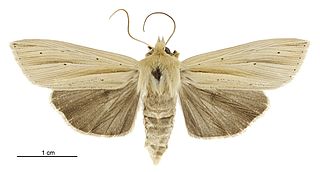
Ichneutica sulcana, the dark underwing wainscot, is a moth of the family Noctuidae. It is endemic to New Zealand and can be found throughout the North, South and Stewart Islands at a range of altitudes from the lowlands to the alpine zone. This species prefers to live in native grass, shrub and wetland habitats as well as in native forest. The larval host plants of this species are forest grasses and sedges and larvae have been reared on Microlaena avenacea and species within the genus Carex. The larva pupates in the soil. Adults are on the wing from December to May but have also been recorded in August and September in the northern parts of the North Island. They are attracted to sugar traps as well as to light. I. sulcana and I. supersulcana are very similar in appearance but can be distinguished as there are differences in the male abdomen and genitalia of the two species. Also these two species do not appear to share a range as I. supersulcana seems to prefer to live at higher altitudes than I. sulcana. I. sulcana might also be confused with I. semivittata but I. sulcana is a larger species with a much darker abdomen and hindwing, and has only 1 to 3 dots on the forewing postmedian line.

Ichneutica unica is a species of moth in the family Noctuidae. It is endemic to New Zealand and is found in the centre of the North Island and throughout the South Island. This moth is very similar in appearance to its close relatives Ichneutica phaula and Ichneutica toroneura. I. phaula can be distinguished as there is a difference in pectinations on the male antennae and I. toroneura can be distinguished as the black vein markings on the forewings is more uniform for that species in comparison to I. unica. I. unica is variable in appearance with the North Island specimens having a darker brown colour on the forewings and having a darker underside of the hindwings. This species inhabits open tussock grassland at various altitudes, coastal dunes, and inland volcanic dunes. Larvae feed on tussock grasses such as Chionochloa pallens and species in the genus Poa. Adult moths are on the wing from November to February and are attracted to both sugar and light traps.

Ichneutica steropastis, or the flax notcher moth, is a species of moth in the family Noctuidae. It is endemic to New Zealand and can be found throughout the country from the Three Kings Islands to Stewart Island as well as in the Chatham Islands. The larvae of this species feed on a variety of native and introduced plants however the New Zealand flax is one of the more well known host plants for the larvae of this moth. The larvae are nocturnal, hiding away in the base of the plants and coming out to feed at night. They create a distinctive notch in the leaf when they feed. The adults of this species are on the wing from October to March. Although adult specimens of I. steropastis are relatively easy to recognise they might possibly be confused with I. inscripta, I. theobroma or with darker forms of I. arotis. However I. steropastis can be distinguished as it has a long dark basal forewing streak that these three species lack.
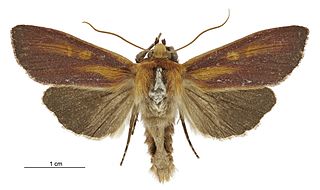
Ichneutica purdii, the orange astelia wainscot, is a moth of the family Noctuidae. It is endemic to New Zealand. It can be found throughout the main islands of New Zealand. I. purdii is a relatively large, colourful moth, unlikely to be confused with any other endemic moth species in New Zealand. The larvae of this moth feed at night on species of Astelia. During the day they shelter in the interior of the plant. When fully grown the larvae can reach a length of approximately 48mm. The larvae are ocherous in colour with a pink flush with line markings but when ready to pupate these markings fade and the larvae take on a light golden hue with a rosy tinge to its rear segments. The deep wine coloured pupa is enclosed in a slight cocoon, with this being constructed below the soil, amongst debris or alternatively within a hollow stick. The adult moths are on the wing from October to March. Although this moth is found throughout the main islands of New Zealand it is more frequent in the south of New Zealand at higher altitudes of up to 1200m.

Ichneutica averilla is a moth of the family Noctuidae. It is endemic to New Zealand. This species is found in the North Island at Mount Taranaki but is widespread throughout the South Island and Stewart Island. It prefers mountainous habitat but can be found down to sea level in the southern parts of the South Island. Adults of the species are on the wing between November and March. Larvae likely exist on a variety of herbaceous plants but have been recorded as feeding on species within the genus Plantago. This species is sometimes confused with I. mutas but can be distinguished from the latter on the basis of forewing colour as well as the absence of or an indistinct antemedian forewing line.

Ichneutica toroneura is a moth of the family Noctuidae. It is endemic to New Zealand. This species is similar to I. unica but can be distinguished from that species by the uniform black vein markings on the forewings of I. toroneura. It is also similar in appearance to I. acontistis but the base of the forewings of I. toroneura lack the dark stripe that can be found on the forewings of I. acontistis. The males of I. toroneura have longer pectinations on their antennae. I. toroneura is found in the centre of southern South Island in the tussock grasslands of Central Otago and the Mackenzie Basin. Larvae feed on tussock grasses Poa cita and Festuca novae-zelandiae. Adults are on the wing from November to January.

Ichneutica paraxysta is a moth of the family Noctuidae. It is endemic to New Zealand. This species is very similar in appearance to its close relative I. acontistis but as the range of the two species do not overlap this is unlikely to cause confusion. I. paraxysta is only found in the North Island at the subalpine zones in the Mount Taranaki region and at Mount Ruapehu. It prefers tussock grassland and shrubland habitat. The life history of this species is unknown as are the host species of its larvae however it has been hypothesised that the larval host plants are species in the genera of Poa and Festuca.
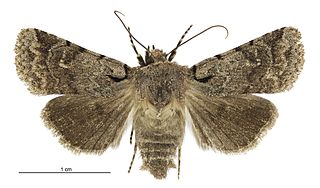
Austramathes fortis is a species of moth in the family Noctuidae. It is endemic to New Zealand and is found in both the North and the South Islands but has yet to be recorded at Stewart Island. It can be found in shrubland containing its host species at a range of altitudes from sea-level up to 1840 m. The larvae of this moth feed on several Melicytus species including M. crassifolius, M. alpinus, M. macrophyllus and M. novae-zelandiae. The larvae pupate in a cocoon of silk at the base of its host plant. It can take between 25 and 45 days before the adult moth emerges. Adults can be found on the wing during the months of July to March. The adults tend to be on the wing in twilight hours but have also been known to be active during the late afternoon. They are attracted to light but this behaviour may limit the number seen at light traps. The distinguishing feature of this moth is the curved black line at the base of its forewing. This species is unlikely to be confused with any other species in its range but it is very similar in appearance to A. squaliolus. However this latter species is only found on the Chatham Islands.

Ichneutica ceraunias is a moth of the family Noctuidae. It is endemic to New Zealand. This species is found from the central North Island to the bottom of the South Island. Hosts of the larvae are species of Chionochloa and Festuca. This colourful moth is variable in appearance and can be mistaken for Ichneutica dione. Adults are on the wing from October to February.
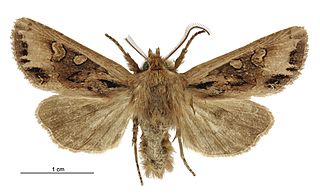
Ichneutica fenwicki is a moth of the family Noctuidae. This species is endemic to New Zealand and is found in the southern parts of the South Island and on Stewart Island. It is a distinctively coloured moth that is unlikely to be confused with closely related species. It is a spring flying moth being on the wing from September to November. The life history and host species of the larvae of I. fenwicki are unknown.
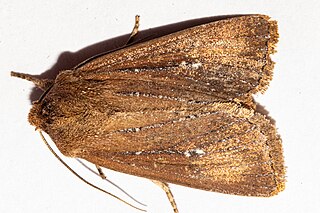
Ichneutica sapiens is a moth of the family Noctuidae. This species is endemic to New Zealand. I. sapiens is found in the central North Island, in the South Island in Westland and also the southern parts of the South Island, and in Stewart Island. This species inhabits wetland habitat but its life history is unknown as are the host species of its larvae. The adult moths are on the wing between December and early January and are attracted to sugar traps and to light. I. sapiens is very similar in appearance to I. micrastra but is a smaller moth with a shorter wingspan, has differently formed antennae and slightly different forewing markings.

Ichneutica paracausta is a moth of the family Noctuidae. This species is endemic to New Zealand. It is found locally in the central North Island, is widespread in the South Island and can also be found in Stewart Island. I. paracausta is variable in colour, but as it has a distinctive black streak on its forewing as well as a wing pattern that is characteristic, I. paracausta is unlikely to be confused with other species. It is present on the North Island volcanic plateau as well as Little Bush Reserve in Hawkes Bay in the North Island as well as in tussock grassland, alpine and subalpine shrubland and in alpine forest. Larvae have been recorded as feeding on grasses, a pupa has been found in a cocoon under the bark of a tree and adult moths are on the wing from October to January.
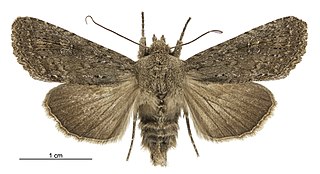
Physetica homoscia is a species of moth of the family Noctuidae. It is endemic to New Zealand and is found throughout New Zealand including in the Auckland Islands. This species inhabits places where its host plants are common and this includes costal dune habitat. It lives at a wide range of altitudes from sea-level up to at least 1750 m. The larvae of P. homoscia feed on Ozothamnus leptophyllus and Ozothamnus vauvilliersii. They are very active and drop to the ground when disturbed. Larvae are parasitised by a species of fly. This species pupates in the soil and the pupa life stage lasts for approximately 6 weeks. The adult moths are on the wing from September to June and are attracted to light. The adults of P. homoscia might possibly be confused with Ichneutica moderata however this latter species lacks the small white dots on the forewing veins of P. homoscia. Adults might also be confused with P. temperata but P. homoscia is significantly larger in size.

























